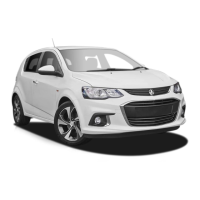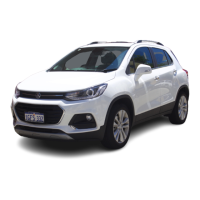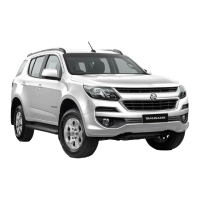
Do you have a question about the HOLDEN MY17 TM Barina and is the answer not in the manual?
| Brand | HOLDEN |
|---|---|
| Model | MY17 TM Barina |
| Category | Automobile |
| Language | English |
Explains warning symbols used in the manual for safety information.
Provides an overview of essential first-time driving procedures and vehicle features.
Details methods for securing and accessing the vehicle using keys and remote controls.
Guides on adjusting front seats for optimal comfort and safety.
Instructions for adjusting head restraints for proper support and whiplash protection.
Explains the proper use and function of seat belts for occupant safety.
Instructions for adjusting interior and exterior mirrors for maximum visibility.
Guides on adjusting the steering wheel for driver comfort and control.
Identifies and explains the function of indicators and controls on the instrument panel.
Details the operation of headlights, park lamps, and other exterior lights.
Explains how to use hazard warning lights in emergency situations.
Instructions for using turn signals for indicating lane changes and turns.
Operation of windscreen and rear window wipers and washers.
Information on operating the vehicle's heating, ventilation, and air conditioning system.
How to clear windows of fog and frost for optimal visibility.
Explains the operation of manual and automatic transmissions.
Basic checks and procedures before starting the engine.
Step-by-step guide for starting the vehicle's engine.
Procedures for safely parking the vehicle.
Information on vehicle keys, remote controls, and locking systems.
Details on the vehicle's foldaway key blade operation and care.
Information on the remote control's function, battery replacement, and operation.
Explains the keyless entry and start system functions and operation.
Operation of central locking via buttons, key, and infotainment system.
Details on manual door locks and child security rear door locks.
Operation and safety precautions for the vehicle's tailgate.
Information on auto door lock/unlock features and vehicle security systems.
Explains the immobiliser system's function to prevent unauthorized starting.
Details on convex and power mirror adjustments for better visibility.
Information on the rear-view mirror and anti-glare function.
Operation of power windows, including auto up/down and anti-pinch features.
Operation of the vehicle's sunroof, including opening, closing, and tilting.
Importance and adjustment of head restraints for safety.
Adjusting front seats for proper driving position and safety.
Detailed steps for adjusting seat position and backrest angle.
Proper fitting and use of the three-point seat belt system.
Specific guidance for pregnant occupants on safe seat belt usage.
Information on the airbag system's operation and safety precautions.
Details about airbags located in the steering wheel and passenger panel.
Explains the function and location of side airbags in the front seats.
Information on curtain airbags stored in the roof pillars.
Guidelines and safety warnings for installing and using child restraint systems.
Guidance on choosing appropriate child seats (infants, young children, boosters).
Proper placement of child restraints in the vehicle, including ISOFIX.
Instructions for using ISOFIX mounting brackets and top-tether anchors.
Overview of various storage locations within the vehicle.
Details on storage located in front of the shift lever and above the glove box.
Operation and safety for the glove box located in the instrument panel.
Location and usage of cup holders in the front and rear consoles.
Information on the sunglasses holder located in the roof.
Details on under-seat storage compartment beneath the passenger seat.
Information on the location and use of the card holder.
Guidelines and precautions for safely loading cargo into the vehicle.
Overview of various vehicle controls.
Step-by-step guide for adjusting the steering wheel for optimal driver position.
Operation of infotainment and cruise control via steering wheel buttons.
How to operate the vehicle's horn.
Operation of front wipers, washers, misting function, and interval adjustment.
Operation of the rear window wiper and washer system.
Display of outside temperature on the infotainment screen.
Setting and displaying the time and date on the infotainment system.
Location and usage of the 12V power outlet.
Identification and explanation of various dashboard warning lights and indicators.
Function of the speedometer for displaying vehicle speed.
Function of the odometer for displaying distance travelled.
Function of the tachometer for displaying engine speed.
Indicates the level of fuel in the tank.
Information on control indicators and their meanings.
Shows selected gear or transmission mode for automatic transmissions.
Operation of turn signals and lane-change signals.
Explains the illumination and flashing of seat belt reminder lights.
Indicates potential issues with airbag or belt tensioner systems.
Warning light indicating a problem with the vehicle's charging system.
Warning light for emission monitoring system faults.
Indicates issues with the braking system or park brake application.
Warning light for faults within the ABS system.
Indicator for optimal gear shifting for fuel economy.
Warning light for faults in the electric power steering system.
Indicator for issues with the park assist system.
Indicates ESC system activation or faults.
Indicates when the TCS system is deactivated.
Warning light for excessively high engine coolant temperature.
Warning light for low engine oil pressure or level.
Indicates a reduction in engine performance due to a system fault.
Indicator for when the high beam headlights are active.
Indicator for when the front fog lamps are switched on.
Indicator for when the tail lamps are illuminated.
Indicator for the status of the cruise control system.
Warning light indicating the bonnet is not fully closed.
Warning light for doors or tailgate not being fully closed.
Reminds driver to operate clutch or brake pedal to start the engine.
Indicates the vehicle requires scheduled maintenance.
Overview of displays like trip computer and driver information centre.
Central display for vehicle information, warnings, and settings.
Accessing and navigating the vehicle's settings menu.
Warning light and chime indicating low fuel level.
Indicates a fault in the immobiliser system preventing engine start.
How to view and confirm vehicle messages and warning codes.
Explanation of vehicle messages displayed with code numbers.
Explains various warning chimes and their priority.
Functions and displays related to the trip computer.
Displays recorded distance since the last reset.
Estimates driving distance based on current fuel level.
Displays current fuel consumption while driving.
Calculates average fuel consumption from ignition on.
Calculates average vehicle speed since last reset.
Customizing vehicle settings via infotainment system.
Overview of exterior lighting functions.
Operation of exterior lamps and automatic light control.
How exterior and instrument panel lights adjust based on ambient light.
Operation of high and low beam headlights and flashing function.
Information on DRL visibility enhancement and operating intensities.
How to activate hazard warning flashers for traffic hazards.
Operation of turn signals and lane change indicators.
Operation of front fog lamps for improved visibility in fog.
Operation of reversing lamps when reverse gear is engaged.
Precautions regarding condensation inside exterior lamp lenses.
Overview of interior lighting systems.
Adjusting the brightness of the instrument panel lighting.
Operation of interior courtesy and load compartment lamps.
Customizing vehicle locator and exit lighting functions.
Function to help locate the vehicle in the dark using exterior lights.
Setting exterior lamps to illuminate the path after leaving the vehicle.
Overview of the infotainment system and safety information.
Warnings and precautions related to electrical shock hazards within the system.
Introduction to the infotainment system's technology and features.
Explains the electronic security system to prevent unauthorized use.
Identification of control panel components and their functions.
Operation of infotainment and cruise control via steering wheel buttons.
Navigating and customizing the infotainment system's home screen menus.
How to select audio sources like AM/FM radio, USB, and Bluetooth.
Viewing picture and movie files from USB storage devices.
Tuning, saving presets, and searching for radio stations.
Adjusting audio settings like bass, midrange, and treble.
Automatic adjustment of volume based on vehicle speed.
Updating the list of available FM/AM radio stations.
Installation and maintenance of fixed mast and multi-band antennas.
Connecting USB storage devices and compatible iPod/iPhone devices.
Playing music files from MTP-compatible devices via USB.
Playing music files from iPod/iPhone devices connected via USB.
Connecting and playing music from auxiliary devices via cable.
Playing music wirelessly from Bluetooth-enabled devices.
Understanding Bluetooth wireless technology and pairing devices.
Using Android Auto and Apple CarPlay for phone projection.
General operation and options within the infotainment system settings menu.
Setting the vehicle's time and date format.
Selecting the display language for the infotainment system.
Managing radio favorites, touch feedback, text scroll, and startup volume.
Customizing vehicle settings through the infotainment system.
Configuring automatic launch of audio or phone projection via USB.
Turning the infotainment display on and off.
Activating and adjusting guidance lines and park assist symbols for the rear camera.
Resetting infotainment system settings to default values.
Displaying open source licensing and system update information.
Overview of the climate control system and its components.
Identification of temperature, fan speed, air distribution, and recirculation controls.
Adjusting the cabin temperature using the temperature switch.
Adjusting the fan speed for airflow intensity.
Selecting air outlet modes for directing airflow within the cabin.
Operation of the air recirculation mode for cabin air quality.
Using the system to demist and defrost the windscreen.
Operation of the air conditioning system for cooling and dehumidifying.
Using maximum cooling for rapid passenger compartment cooling.
Adjusting air vents for directing airflow.
Directing airflow by tilting the cabin air vents.
Location of fixed air vents in the vehicle.
Information on vehicle care related to the climate control system.
Location and maintenance of the air intake system.
Function and replacement of the passenger compartment air filter.
Recommended operation of the AC system for efficient performance.
General guidance for driving the vehicle safely.
Pre-driving checks including windows, mirrors, lamps, and tyre inflation.
Steps to take before starting to drive, including securing doors and seat belts.
Procedures for starting the engine and initial vehicle operation.
Precautions for the initial period of vehicle use to improve performance.
Important notes and cautions regarding the vehicle's braking system.
Explanation of the ignition switch positions and their functions.
Detailed steps for starting the engine with ignition switch or electronic key.
How the steering wheel lock engages and disengages.
How electrical systems remain active after ignition is switched off.
Procedures for safely parking the vehicle, including gear selection and wheel positioning.
Safety information regarding engine exhaust gases and carbon monoxide.
Function of the catalytic converter and precautions related to fuel quality.
Operation and selection of gears in the automatic transmission.
Explanation of the shift lever positions (P, R, N, D, M).
How to use the manual mode for gear shifting.
Utilizing engine braking for control when driving downhill.
How to achieve faster acceleration using the kickdown function.
Feature to reduce fuel consumption when idling.
Indicates transmission faults and associated warning lights.
Procedure to release the shift lever from Park (P) position in emergencies.
How ABS operates and safety considerations for its use.
Operation and deactivation of the TCS system for stability.
How ESC enhances driving stability and its activation.
Operation and settings for the cruise control system.
Overview of parking assist sensors and rear vision camera systems.
Functionality, activation, and deactivation of the Park Assist system.
How the rear vision camera assists when reversing.
Safety warnings and precautions regarding fuel handling and storage.
Use of genuine parts and information on emission control systems.
Major emission control systems in the vehicle and recommended servicing.
Driver's responsibility regarding the engine, control system, and exhaust modifications.
Importance of regular servicing by authorized dealers.
Procedures for storing the vehicle for extended periods and preparing it for use.
Routine checks for power windows, tyre pressures, fluid levels, etc.
Safety precautions when working on the vehicle's engine compartment.
Instructions for opening and closing the vehicle's bonnet.
Identification of key components within the engine compartment.
Checking and adding engine oil, including oil change intervals.
Servicing requirements for automatic transmission fluid.
Replacement procedure for the engine air filter.
Checking and adding engine coolant, with safety precautions.
Checking and adding power steering fluid levels.
Checking and adding washer fluid, and cleaning wiper blades.
Checking and adding brake fluid, with safety and disposal precautions.
Safety precautions for handling the battery and its replacement.
Steps for disconnecting the vehicle battery.
General guidance on replacing bulbs and specific bulbs requiring dealer service.
Replacement procedures for headlights and front turn signals.
Replacement procedures for rear lighting components.
Procedure for replacing the number plate lamp bulb.
Replacing interior lamps, including the load compartment lamp.
Information about fuses and the fuse extractor tool.
Precautions and guidelines for replacing blown fuses.
How to use the fuse extractor tool for safe fuse removal.
Location and diagram of the engine compartment fuse box.
Location and cover removal for the instrument panel fuse box.
Information about the tyre repair kit and tools.
Details on the tyre repair kit for minor tyre damage.
Operation and limitations of the emergency tyre repair kit.
Location of the spare tyre, jack, and tools.
Information on tyre and rim condition and regular checks.
How to avoid tyre damage and check for wear and damage.
Importance of maintaining correct tyre pressures for safety and efficiency.
Location of correct tyre pressures on the passenger door frame.
How to check tyre tread depth and when to replace tyres.
Recommendations for rotating tyres to ensure even wear.
Guidance on selecting and fitting new tyres for safety and performance.
Permitted use and precautions for fitting tyre chains.
Detailed steps for temporary tyre repair using the kit.
Procedures for safely changing a wheel and removing/installing the spare tyre.
Steps to safely remove the spare tyre from its compartment.
Warnings and procedures for jump starting a vehicle with a flat battery.
Methods for towing the vehicle using flat-bed or standard tow trucks.
Best method for towing to avoid vehicle damage.
Alternative towing methods using standard trucks and dollies.
Safety precautions and procedures for towing the vehicle, including using the towing eye.
Procedure for attaching towing equipment to another vehicle.
Guidelines for maintaining the vehicle's exterior appearance.
Washing, waxing, and cleaning exterior surfaces.
Procedures for washing the vehicle, including hand wash and automatic wash.
Cleaning and maintenance of exterior lamp covers.
Clearing debris from air intakes during washing.
Procedures for polishing and waxing the vehicle's paintwork.
Cleaning glass, wiper blades, and rear window heating element.
Cleaning wheels and tyres, avoiding high-pressure jets.
Rectifying minor paintwork damage and rust repairs.
Cleaning and inspecting the vehicle's underbody for rust prevention.
Cleaning interior surfaces, avoiding harsh chemicals, and ventilation.
Cleaning interior panels, fabric upholstery, and seat belts.
Cleaning plastic and rubber parts using appropriate cleaners.
Importance of maintenance for economical and safe vehicle operation.
Reference to service schedules in the Service/Warranty Booklet.
How the system monitors and indicates engine oil and filter change needs.
Specifications for engine oil, coolant, transmission fluid, and other fluids.
Information on Vehicle Identification Number (VIN) and identification plate.
Location of the VIN on the vehicle firewall and windscreen.
Details shown on the vehicle's identification label on the door frame.
Location of the engine serial number.
Specifications for engine type, cylinders, power, torque, and octane rating.
Detailed engine specifications including type, cylinders, power, and torque.
Information on vehicle weight and maximum payloads.
Load limits for occupants, luggage, and total vehicle weight.
Maximum front and rear axle load capacities.
Vehicle dimensions including length, width, height, and wheelbase.
Fluid capacities for engine oil, coolant, and fuel tank.
Importance of maintaining correct tyre pressures for safety and efficiency.
General information regarding customer support and vehicle ownership.
List of trademarks and registered logos used in the manual.
Options for seeking assistance from Holden Customer Care and Dealerships.
Contact details and operating hours for Holden Customer Care.
Address and required information for contacting Holden via mail.
Information specific to New Zealand regarding warranty and owner assistance.











